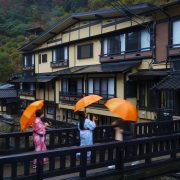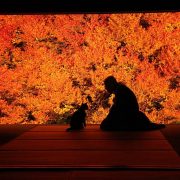12 amazing things to do and see in Okinawa, Japan
Okinawa is one of Japan’s most surprising prefectures. There are 160 large and small islands including 47 inhabited islands dotted over an area that covers about 400 kilometres north-to-south and 1,000 kilometres east-to-west. It offers coral reefs, crystal-clear blue seas, white sand beaches, and beautiful natural scenery. Visitors will also experience the unique Ryukyu culture and legends. Here are the top 12 reasons to go!
The Beaches
It impossible to look past the stunning waters that surround Okinawa, Japan. With their pristine soft sand and turquoise coloured waters, the sea here is home to stunning coral reefs and an abundance of marine life. Every beach in Okinawa offers travellers something different and unique. From the star-shaped sand at Kaiji Beach on Taketomi Island, Travellers can choose to snorkel, snorkelling amongst the stunning fish at Aharen Beach on the Kerama Islands, dive amongst the ancient ruins off the coast of Japan’s westernmost island Yonaguni, or swim amongst the gorgeous green sea turtles at Ama Beach on Zamami Island in the Kerama blue waters.
Awamori
Known as the “Happiest Spirit on the Planet” – Awamori is the oldest distilled alcoholic drink in Japan, and is believed to be the predecessor of shochu. Indica, also called Thai rice, is malted, becoming koji, which is then fermented with the addition of water and yeast before undergoing a single distillation to complete awamori. This technique is said to have remained almost unchanged for 500 years. One of the distinct features of awamori involves the black koji mold. The mold generates a large amount of the strongly bactericidal citric acid, and is optimal for making sake in Okinawa, a hot and humid place where bacteria easily grow. The koji mold is unique to Okinawa and is used in no sake brewing technique outside of awamori. Thai rice is used instead of Japanese rice is because Thai rice, being hard and smooth, can facilitate the extension of the hyphae of the black koji mold. In other words, it makes the production of malted rice easier.
More than anything, awamori is characterized by its long-term storage, which allows its ingredients to mature and add a mellow savour to it. If stored for three years or longer, awamori can be referred to as kusu, or aged sake.
See waterfalls as you trek through some scenic sub-tropical rainforests
Trekking is a popular way to experience the island’s subtropical forests. Hiji Falls, which has the largest flow of water by volume of all the Okinawan waterfalls, is recommended for both beginners and advanced trekkers who may encounter diverse plant and animal life as well as the stunning views of the river and surrounding forest. Venture further north and surround yourself with natural pristine beauty in the Yanbaru region of Okinawa and try your luck in spotting an Okinawa Rail, a native bird only found in the Yanbaru region of Okinawa.
Visit Scenic Kabira Bay on Ishigaki Island
Ishigaki Island is rich in nature and musical traditions. You will find the delicate notes of sanshin accompanying the distinctive songs of the island, it is a wonderful accompaniment to the wide range of experiences available on this island rich in nature’s gifts. Kabira Bay is Ishigaki Island’s iconic scenic spot and truly represents the allure of Okinawa. Within the bay is a pure white sand beach, contrasting the green colour of nine small islands, the clear blue sky, you can see intense gradients of blue, and it all comes together spectacularly. While swimming is prohibited, you can enjoy watching the colourful tropical fish swimming from a glass boat. When visiting Ishigaki Island, this is certainly one place you don’t want to miss.
Eat a Longevity Meal at Nuchigafu and sample a traditional foamed Bukubuku Tea
Located in one of the stunning side streets of the Tsuboya district and only a five-minute walk from Kokusai-dori Street, Nuchigafu is a gorgeous restaurant where you can sample the very best of Ryukyuan cuisine and cultures. The restaurant is situated inside an old Okinawan style house which was built originally as a radio station and guests here can expect to receive traditional Ryukyuan hospitality. The colourful dishes are served using ingredients that are local and organic. Sample the longevity meal which includes some bitter melon (Goya) and try out the Bukubuku tea which is specially made in front of you as you watch the roasted rice broth be whipped up before your eyes. Bookings here are recommended.
Stay at HOSHINOYA Taketomi Island
Discover the beauty of HOSHINOYA Taketomi Island, more like an Okinawan village melding into the island landscape than an accommodation facility. Every guestroom is a detached bungalow with Ryukyuan red-tile roof and private garden. You’ll feel just like an islander. The acclaimed, original dishes at the restaurant are prepared with a touch of French flare making the most of the ingredients found in the Yaeyama Islands.
Create your own piece of traditional Tsuboya Pottery
Whether you are sitting at a dining table or walking through the aisles of a souvenir shop, the eyes are automatically drawn to the colours and craftsmanship of traditional Okinawan pottery. Known as yachimun in Okinawan language, these plates, bowls, figurines, and much more, are functional, elegant and part of everyday life on these islands. Dig a little deeper, however, and you find that yachimun pottery also has an interesting story to tell about Okinawa, its history, and its people’s appreciation for aesthetic beauty that matches its surrounding physical beauty. There is no better way to get a quick introduction to the history and charms of this Okinawan craft than to visit Naha’s Tsuboya Yachimun Street. While only a short walk away from the tourist hubbub of Kokusai Street, the limestone paved road running through the small district is just the first indication that you are entering one of the most charming parts of the city. Somewhat miraculously, the Tsuboya area escaped much of the devastation inflicted on the rest of Naha during the Battle of Okinawa, and the streetscape with its narrow winding alleys, known as sujiguwa in Okinawan language, gives a glimpse of a time gone by.
Dotted around the area are also potters at work, many with open studios you can enter and see the artisans producing works ranging from the very functional to the most elaborately designed pieces incorporating modern techniques. A number of studios also have yachimun experience classes, where you can try your hand at making some household wares or Shisa statues. These Shisa Statues is a traditional statue of the Ryukyuan culture and they resemble a cross between a lion and a dog. These statues came from Okinawan mythology and are used as protection from evil spirits.
Witness Japan’s Earliest Cherry Blossom Bloom
The arrival of cherry blossoms is the highlight of the Japanese year. Young and old celebrate the fleeting beauty of these delicate flowers. Okinawa’s subtropical climate means it is the first place in Japan to enjoy the festivities. From mid-January to mid-February, dark pink blossoms bring joy to both Okinawa’s residents and visitors.
In Okinawa, the cherry trees not only bloom earlier than in mainland Japan, but the flowers are quite different. The most common Japanese cherry trees are the Yoshino cherry (Somei Yoshino) and the yamazakura. These trees both produce delicate blossoms that are pale pink, almost white. The most common variety of cherry tree in Okinawa is the hikanzakura, also known as the Ryukyu kanhizakura, or the Taiwanese cherry. Okinawa’s cherry blossoms have a sturdy, bell-like shape and hang down from the tree. The flowers’ petals are also a dark pink compared to the almost white petals of the Yoshino cherry. The beautiful bold colour of the flowers make the pink cherry trees stand out on the verdant mountains.
The cherry trees also differ in how they finish blossoming. The flowers of the Yoshino cherry lose their petals one by one, sometimes creating clouds of white petals after a strong breeze, while the dark pink flowers of the Okinawan hikanzakura fall intact to the ground.
Yoga at the Katsuren Castle World Heritage Site
Connect with Okinawa’s natural beauty with outdoor Yoga. Okinawa’s endemic life energy makes it an ideal destination for yoga practitioners. A variety of settings are available, such as breezy white sandy beaches or the ancient Katsuren Castle Site (designated World Heritage Site), each allowing practitioners of all levels to find freedom and inspiration in the body and mind.
Ogimi Village
Okinawa Prefecture is known for the longevity of its people, but Ogimi Village in the Northern Okinawa Main Island is specifically known as the “Village of Longevity”, and people conscious of their health are becoming more and more aware of Ogimi’s name not only in Japan but throughout the world.
The elements that support the mindset able to make such a powerful declaration contain the wisdom of longevity. So, what are those elements? When you actually visit Ogimi Village and talk to people, three main components emerge.
- Our rich natural environment includes the sea, rivers, and mountains, and we live “without worry or hurry,” and relax
- We practice a diet that includes a wide range of nutrients from various sources such as meat (animal protein), island vegetables, and fruits.
- In the spirit of the “lifelong activity”, we participate in the events and social activities of our village.
Visit Okinawa’s Peace Memorial Park
The Main Island Southern Region was the site of a hard-fought battle between Japan and the U.S. in World War II. Today, there are many museums and monuments honouring the memory of those who lost their lives during this difficult time. Okinawa Prefectural Peace Memorial Park located on the hills of Mabuni is one such site. The Okinawa Prefectural Peace Memorial Museum in the park displays rare photos, as well as the personal testimonies from Okinawans to remind us of the bloodiness of war. Moreover, A Cornerstone of Peace was erected to mark the 50th anniversary of the end of the Battle of Okinawa and World War II. Inscribed on it are the names of all those who died in the fighting irrespective of nationality. Even today, many visitors can still be seen placing flowers on the Himeyuri-no-to Monument and Himeyuri Peace Museum in honour of the Himeyuri Student Corps.
Taste Okinawan Beer at Orion Happy Park!
Orion was established by Sosei Gushiken on May 18, 1957. The founder’s strong determination to develop the manufacturing industry in Okinawa for the post-war economic and social reconstruction led to the establishment of the company, which has ever since grown into one of the leading companies in the prefecture.
The name “Orion” was originally the name of the beer sold by the company, which had been determined by inviting the public to name the beer. The public invitation to name the beer was placed in newspapers on November 1, 1957, with prizes offered. The contest attracted more than 2,500 entries with 823 names. Of these, 810 names were screened, and “Orion” was selected for its association with Okinawa and level of appeal to consumers.
Orion is, needless to say, the name of a constellation. Orion is a constellation in the southern sky and matches the image of the southern island Okinawa. Stars are often used as a symbol of dreams and aspiration. And the commander of the U.S. forces governing Okinawa at that time was wearing the three-star emblem. These are the main reasons for the selection of the name. A symbolic beer that represents the Okinawan culture and history.


















